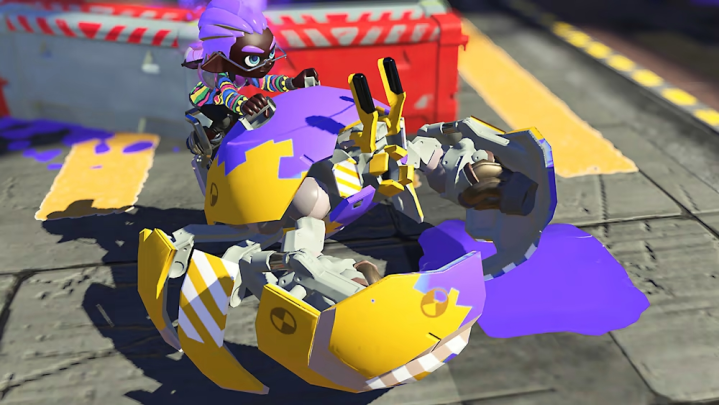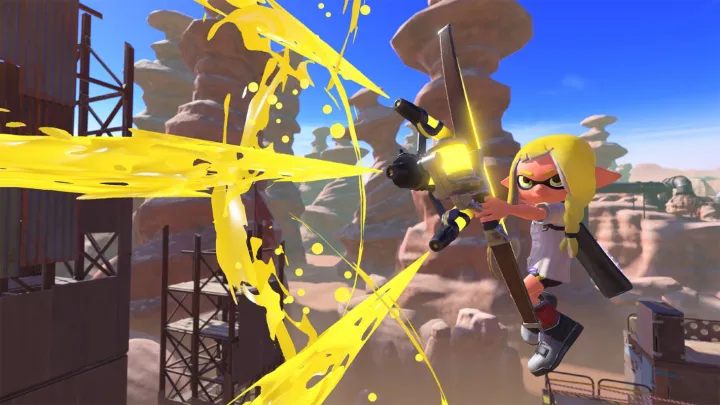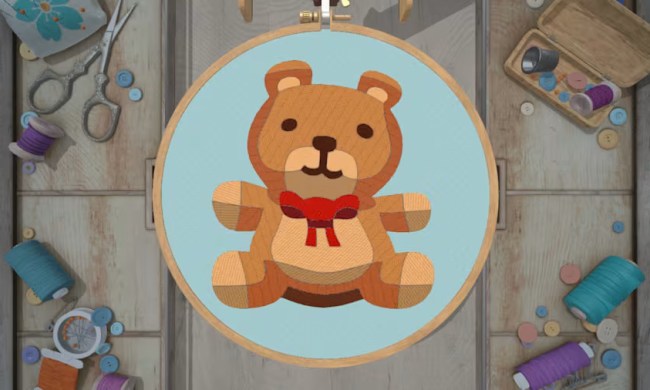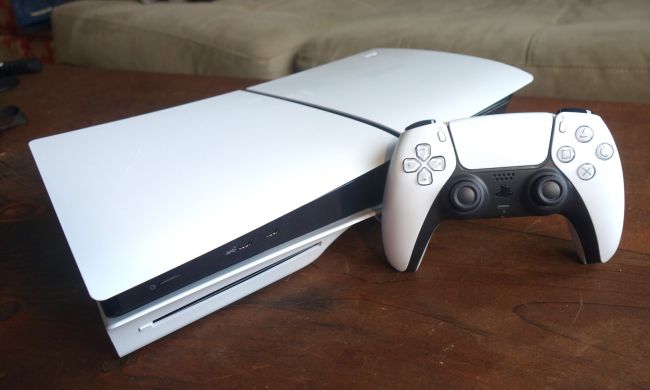Over the last seven years, Splatoon has quietly evolved into one of Nintendo’s top-tier franchises. Starting with a surprise hit on the Wii U, the series quickly found devoted fans on both the casual and competitive sides. Splatoon 2 pushed that momentum, but it was seen as more of a “Splatoon 1.5” at the time — a slightly updated version of the first game for the Switch’s much larger install base. Despite the series’ success, it’s still been waiting for that true breakout moment.
Splatoon 3 just might be it.
At a press event, I went hands-on with the threequel, playing a snippet of its single-player campaigns, the newly retooled Salmon Run mode, and a few rounds of Turf War. While it’s largely the same game (in a good way), Nintendo has focused on small tweaks that should go a long way. New weapons, ingenious abilities, and tweaked movement seem like they’ll crack the series open for the competitive scene.
Considering the much-needed quality of life changes coming alongside the new content, I walked away from my play session convinced Splatoon 3 will be the Switch’s next must-own multiplayer game, right next to Super Smash Bros. Ultimate and Mario Kart 8 Deluxe.
Splashing back in
At a glance, Splatoon 3 doesn’t seem much different than its predecessor. Take its story campaign for instance. As part of my preview, I played three quick levels, which felt very similar in structure to Splatoon 2’s Octo Expansion. When I hopped into a mission, I’d have to pick a weapon for the job and pay a little bit of currency to enter a short gauntlet that would test my platforming and inking skills. One level had me collecting three keys by reintroducing me to Splatoon staples like a rubbery path that rolls forward when I shoot ink at it.
The lore only gets weirder from here on out.
The campaign seems to be a clever way to create an extended tutorial for newcomers and to introduce the game’s new gear. One mission I tried is built around the Tri-Stringer, a bow and arrow that fires three ink shots. In that level, I had to master the bow’s nuances, learning how to switch its shot pattern from horizontal to vertical by jumping and firing in midair. One small section has me shooting a charged shot at a moving wall behind some riot-shielded enemies. It’s a subtle way to teach me how the weapon’s exploding shot works without throwing tutorials on screen. Once I played that mission, I felt like I was in good shape to start testing the tool out in a multiplayer battle without having to learn on the fly.
That experience is intended, according to Nintendo. After my preview, I sat down with Nintendo VP of Player and Product Experience Bill Trinen and SVP of Product Development and Publishing Nate Bihldorff. The two confirm that the story mode is meant to teach players the basics of the game, while still building up to a challenging test of skill in its own right. But more important to the campaign this time around is the role it plays in worldbuilding.
“The more important part of the campaign in terms of size is the way that it expands the universe of Splatoon,” Bihldorff tells Digital Trends. “This has always been one of our franchises with the weirdest lore and I can certainly tell you that the lore only gets weirder from here on out.”
Make a run for it
The second part of my hands-on was with Salmon Run, the series PVE mode where a team of four beat back waves of incoming enemies. The main difference this time is that it’s no longer a limited-time mode that can only be played in specific windows. It’s available all the time. Trinen explains that making Salmon Run always available should help improve the player base’s overall literacy for it.
“With it available all the time, I think you’re going to see a larger pool of players who have a solid understanding of the way Salmon Run works,” Trinen tells Digital Trends. “You’re going to start to see players on an individual basis getting better at Salmon Run. And as you get matched with players who understand and are better at Salmon Run, that’s going to enable you to get deeper into the peak of what it has to offer.”

While there are some tweaks to the mode, like added bosses, Salmon Run largely felt similar to what I experienced in Splatoon 2 — in a good way. It’s still a fun, frantic PVP mode that gets tense as the waves escalate. The notable changes come in the form of smaller details, like the ability to now toss an egg into the basket from afar. It’s a tiny change, but something that makes the pace of the mode feel quicker, as players don’t need to trudge all the way back to the basket to drop their bounty.
Though I only played a few pieces of various modes, I can already feel how they’ll naturally click together. There’s a real sense that players are living in an ecosystem this time around; they’re not just popping into a menu to start a multiplayer round and exiting to another menu. If the campaign is a school teaching the ins and outs of the game, a mode like Salmon Run feels like a (very fun) day job in the world of a Splatoon player, something that their crew clocks into to get some rewards.
Time to pop off
What really got me excited about Splatoon 3’s potential is when I hopped into a few rounds of Turf War, the series’ signature competitive mode. The game itself is identical to the first Splatoon, with two teams inking as much territory as they can in a few minutes. But the more I played, the more I began to feel just how much of an impact some of the game’s new tools have.
Take the Splatana for instance. In my first round, I equipped the sword-like weapon (which looks like a windshield wiper). It instantly became one of my favorite weapons in the series. It’s an incredibly powerful offensive tool that can chop up an enemy quickly, while still splashing some ink forward on each swing. I can see how it’ll be a potentially powerful tool in other competitive modes, essentially letting teams assign one player the role of close-range assassin.

That “team comp” idea feels much more achievable here than it has in previous games. One weapon’s super ability allows me to drop a Tacticooler, a tool that allows my teammates to grab a speed-increasing and respawn-timer-reducing buff. As I played, I was starting to construct what a proper Splatoon team could look like, with one player providing support while another focuses on splatting enemies with ease. Splatoon 3 doesn’t go full Overwatch with role assignments, but it feels like high-level teams will be able to treat it as such.
The game also features some subtle movement techniques that won’t mean much to casual players, but could be massive for veterans. For instance, players can now boost up a wall quickly by holding down a trigger. There’s also a new maneuver that lets players easily do a quick 180-degree turn while swimming in ink, almost acting as a roll dodge. Both are small additions, but ones I can picture leading to some exciting plays for dedicated players.
We’re going to embrace chaos these first couple months when it launches.
Everything really came together in my last round of Turf War. After spending a few games experimenting with weapons and regaining my sea legs, I got serious and equipped my go-to weapon: a paintbrush. I quickly transformed into a force of nature, racking up multi-splats. As the timer ticked down, I realized that my super was charged: the zipcaster. The tool briefly turns you into Spider-Man, allowing you to zip to far-off walls. My opponent’s team was in the process of respawning after a team wipe, so I used it to jump behind them and rack up some last-second splats, dashing their hopes for a comeback. It’s among the most satisfying things I’ve ever pulled off in the series and the closest I’ve ever felt like the game has come to having a “play of the game” moment.
Embracing chaos
It’s not just pro players who will benefit from all these, but newcomers, too. Bihldorff explains that the range of new items and moves should create surprises for even series veterans, allowing brand-new players to get the jump on their opponents in the early days of its lifecycle.
“It completely disrupts the game in a good way, as it should,” Bihldorff says. “Not only do these new weapons and sub-weapons require people to learn, but everyone else is going to have to learn how to deal with them, even if they’re not using them. Since you have so many different combos of weapons with new sub-weapons and new moves, all that together will require even the most masterful players to rethink their entire approach to the game.”

Bihldorff says he’s particularly excited for those early stages where players are scrambling to learn the game’s completely new meta. Based on my short time with it, I can already feel the level of delightful mayhem that’s in store. The fanbase only has itself, and its voting decisions during Splatoon 2’s last Chaos vs. Order Splatfest, to thank for that.
“It encapsulates the whole idea of chaos, which this whole game is based on,” Bihldorff says. “It would have been a very different game had Order won the last Splatocalypse. I think we’re going to embrace chaos these first couple months when it launches.”
Splatoon 3 launches on September 9 for Nintendo Switch. Players can try the game on August 27 during a demo event.



